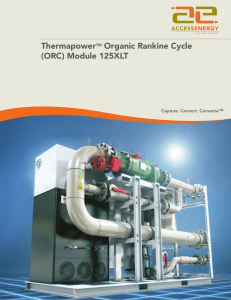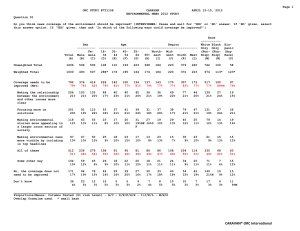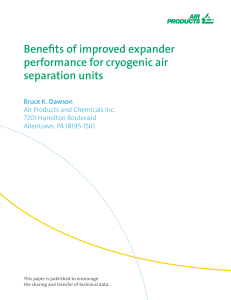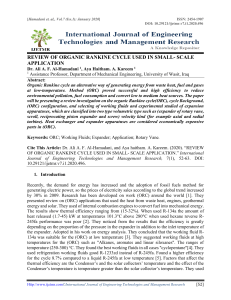Generating Renewable Electric Power and Reducing Carbon
advertisement
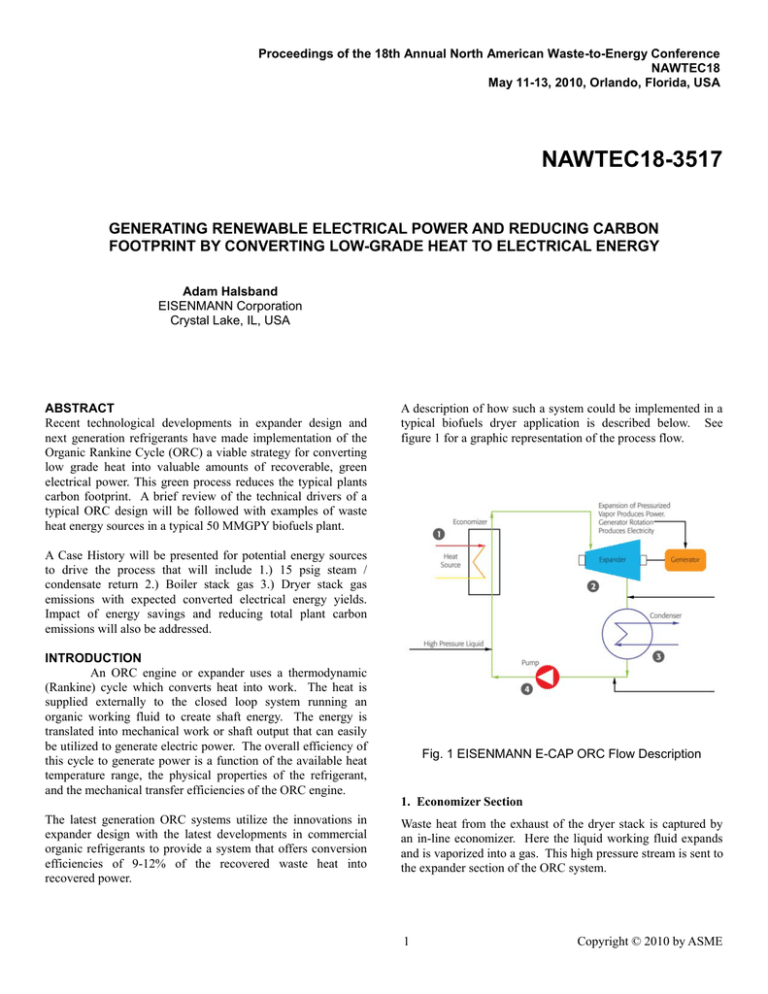
Proceedingsofofthe the18th 18th Annual Annual North North American American Waste-to-Energy Waste-to-Energy Conference Conference Proceedings NAWTEC 18 NAWTEC18 May 11-13, 11-13, 2010, 2010, Orlando, Orlando, Florida, Florida, USA USA May NAWTEC18-3517 GENERATING RENEWABLE ELECTRICAL POWER AND REDUCING CARBON FOOTPRINT BY CONVERTING LOW-GRADE HEAT TO ELECTRICAL ENERGY Adam Halsband EISENMANN Corporation Crystal Lake, IL, USA ABSTRACT Recent technological developments in expander design and next generation refrigerants have made implementation of the Organic Rankine Cycle (ORC) a viable strategy for converting low grade heat into valuable amounts of recoverable, green electrical power. This green process reduces the typical plants carbon footprint. A brief review of the technical drivers of a typical ORC design will be followed with examples of waste heat energy sources in a typical 50 MMGPY biofuels plant. A description of how such a system could be implemented in a typical biofuels dryer application is described below. See figure 1 for a graphic representation of the process flow. A Case History will be presented for potential energy sources to drive the process that will include 1.) 15 psig steam / condensate return 2.) Boiler stack gas 3.) Dryer stack gas emissions with expected converted electrical energy yields. Impact of energy savings and reducing total plant carbon emissions will also be addressed. INTRODUCTION An ORC engine or expander uses a thermodynamic (Rankine) cycle which converts heat into work. The heat is supplied externally to the closed loop system running an organic working fluid to create shaft energy. The energy is translated into mechanical work or shaft output that can easily be utilized to generate electric power. The overall efficiency of this cycle to generate power is a function of the available heat temperature range, the physical properties of the refrigerant, and the mechanical transfer efficiencies of the ORC engine. Fig. 1 EISENMANN E-CAP ORC Flow Description 1. Economizer Section The latest generation ORC systems utilize the innovations in expander design with the latest developments in commercial organic refrigerants to provide a system that offers conversion efficiencies of 9-12% of the recovered waste heat into recovered power. Waste heat from the exhaust of the dryer stack is captured by an in-line economizer. Here the liquid working fluid expands and is vaporized into a gas. This high pressure stream is sent to the expander section of the ORC system. 1 Copyright © 2010 by ASME 2. Expander Section In the expander section, the pressurized working fluid is forced through the screw expander. This twin screw expander operates at much higher levels of efficiency and reliability when compared to turbo-type expanders. The screw expander turns a shaft to spin an electric generator. The electricity generated is 60 Hz AC “green power” which can be used directly by the facility or sold back to the grid. 3. Condenser Section The low pressure vapor is cooled and condensed back into a liquid in the condenser. Boiler makeup water for the plant could be used as the coolant and can later be used as preheated boiler feed water. Alternatively, air can be used to cool the condenser; combustion air preheating for any fired piece of equipment is an easy integration. 4. Pressurization Section The working fluid is pumped to higher pressure and returned to the evaporator to repeat the process. RESULTS AND DISCUSSION Case Study: Putting Waste Heat to Work->Dryer Stack Emissions US Biofuels Industry 8-10 MMBTU/hr equivalence worth of reduced heating expense (by preheating boiler feed water, plant water, or combustion air). Carbon Credits derived from reduction of fossil fuel consumption. Potential local utility and state incentives for reducing peak power consumption / increased efficiency measures. Depending on the local value placed on the above benefits and ease of integration, these systems can deliver ROI’s in the 2-5 year range. CONCLUSIONS The recent developments in ORC engine design coupled with advances in commercially available refrigerants provides an opportunity to access waste heat sources that was not previously economically viable. In the world of first generation biofuels this new system offers a possibility to tap waste heat sources in an economic and environmentally attractive manner to help reduce the overall carbon footprint of these facilities. Most first generation biofuel plants in the US require the capability of drying various solid co-products to an acceptable level of moisture. The vaporized moisture and air from the dryer operation is often subject to a thermal treatment step to meet desired stack emissions targets. A typical application representative of the industry: Flow: 65,000 Wet SCFM Temperature: 300 to 320ºF Composition (volume): 50-55% Dry air / Remainder Water Vapor The above stream is typically rich in available enthalpy at over 100 MMBTU/hr. Historically this energy was not economic to recover due to the low relative temperature of the energy. Utilizing an ORC approach as described above we are able to contact this heat and place it to useful work utilizing a stack economizer in a manner which previously was not cost effictive. Under the conditions shown above, this system would deliver the following potential benefits to the typical facility: 500-600 kW of generated electricity or approximately 700 HP worth of mechanical power 2 Copyright © 2010 by ASME
